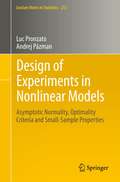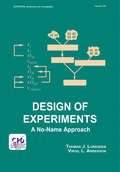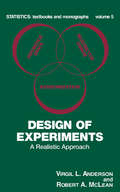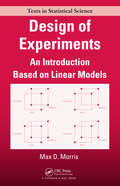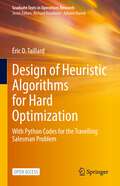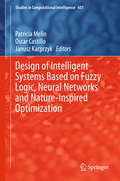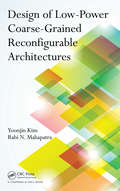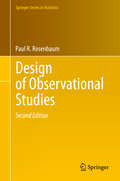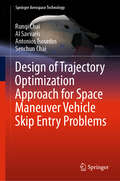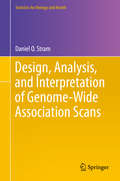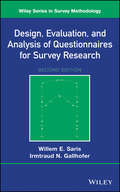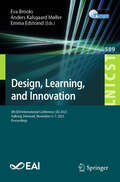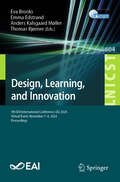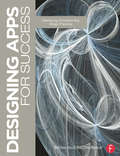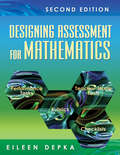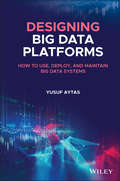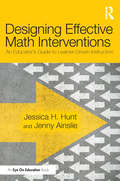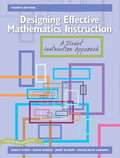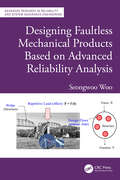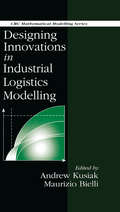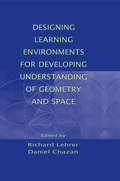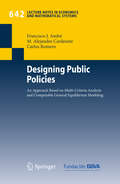- Table View
- List View
Design of Experiments for Pharmaceutical Product Development: Volume II : Applications and Practical Case studies
by Sarwar BegThis book volume provides complete and updated information on the applications of Design of Experiments (DoE) and related multivariate techniques at various stages of pharmaceutical product development. It discusses the applications of experimental designs that shall include oral, topical, transdermal, injectables preparations, and beyond for nanopharmaceutical product development, leading to dedicated case studies on various pharmaceutical experiments through illustrations, art-works, tables and figures. This book is a valuable guide for all academic and industrial researchers, pharmaceutical and biomedical scientists, undergraduate and postgraduate research scholars, pharmacists, biostatisticians, biotechnologists, formulations and process engineers, regulatory affairs and quality assurance personnel.
Design of Experiments in Nonlinear Models
by Luc Pronzato Andrej PázmanDesign of Experiments in Nonlinear Models: Asymptotic Normality, Optimality Criteria and Small-Sample Properties provides a comprehensive coverage of the various aspects of experimental design for nonlinear models. The book contains original contributions to the theory of optimal experiments that will interest students and researchers in the field. Practitionners motivated by applications will find valuable tools to help them designing their experiments. The first three chapters expose the connections between the asymptotic properties of estimators in parametric models and experimental design, with more emphasis than usual on some particular aspects like the estimation of a nonlinear function of the model parameters, models with heteroscedastic errors, etc. Classical optimality criteria based on those asymptotic properties are then presented thoroughly in a special chapter. Three chapters are dedicated to specific issues raised by nonlinear models. The construction of design criteria derived from non-asymptotic considerations (small-sample situation) is detailed. The connection between design and identifiability/estimability issues is investigated. Several approaches are presented to face the problem caused by the dependence of an optimal design on the value of the parameters to be estimated. A survey of algorithmic methods for the construction of optimal designs is provided.
Design of Experiments: A No-Name Approach (Statistics: Textbooks and Monographs #139)
by THOMAS J. LORENZEN AND VIRGIL L. ANDERSONPresents a novel approach to the statistical design of experiments, offering a simple way to specify and evaluate all possible designs without restrictions to classes of named designs. The work also presents a scientific design method from the recognition stage to implementation and summarization.
Design of Experiments: A Realistic Approach (Statistics: Textbooks and Monographs #5)
by Virgil L. Anderson Robert A. McLean<p>The book is written for anyone who wants to design experiments, carry them out, and analyze the results. The authors provide a clear-cut, practical approach to designing experiments in any discipline and explain the general principles upon which such design is based. The reader then can apply these theories to any specific problem in his own work. <p>No advanced mathematics is needed to utilize Design of Experiments – the necessary statistical concepts and briefly reviewed in the first two chapters. Subsequent chapters explain why and how the design of experiments in an intrinsic part of the scientific method, what problems will be encountered by the researcher in setting up his experiment and how to deal with them, and how to accurately analyze the result in terms of the sample taken and the method used. Each chapter includes problems encountered in specific fields so that the reader can test himself on his comprehension of the material. The diversity of the applications that these problems encompass also allows the reader to grasp the basic principles that unite the statistical approach to experiment design. <p>Researchers and students in engineering, agriculture, pharmacy, veterinary science, chemistry, biology, the social; sciences, statistics, mathematics, or any other field that requires the design, solution, and analysis of problems will find this book absolutely indispensable.</p>
Design of Experiments: An Introduction Based on Linear Models (Chapman & Hall/CRC Texts in Statistical Science)
by Max MorrisOffering deep insight into the connections between design choice and the resulting statistical analysis, Design of Experiments: An Introduction Based on Linear Models explores how experiments are designed using the language of linear statistical models. The book presents an organized framework for understanding the statistical aspects of experiment
Design of Experiments: Statistical Principles of Research Design and Analysis (2nd Edition)
by Robert O. KuehlThis edition prepares students to design and analyze experiments that will help them succeed in the real world. The author uses a large array of real data sets from a broad spectrum of scientific and technological fields. He emphasizes the importance of developing a treatment design based on a research hypothesis as an initial step, then developing an experimental or observational study design that facilitates efficient data collection.
Design of Heuristic Algorithms for Hard Optimization: With Python Codes for the Travelling Salesman Problem (Graduate Texts in Operations Research)
by Éric D. TaillardThis open access book demonstrates all the steps required to design heuristic algorithms for difficult optimization. The classic problem of the travelling salesman is used as a common thread to illustrate all the techniques discussed. This problem is ideal for introducing readers to the subject because it is very intuitive and its solutions can be graphically represented. The book features a wealth of illustrations that allow the concepts to be understood at a glance. The book approaches the main metaheuristics from a new angle, deconstructing them into a few key concepts presented in separate chapters: construction, improvement, decomposition, randomization and learning methods. Each metaheuristic can then be presented in simplified form as a combination of these concepts. This approach avoids giving the impression that metaheuristics is a non-formal discipline, a kind of cloud sculpture. Moreover, it provides concrete applications of the travelling salesman problem, which illustrate in just a few lines of code how to design a new heuristic and remove all ambiguities left by a general framework. Two chapters reviewing the basics of combinatorial optimization and complexity theory make the book self-contained. As such, even readers with a very limited background in the field will be able to follow all the content.
Design of Intelligent Systems Based on Fuzzy Logic, Neural Networks and Nature-Inspired Optimization
by Oscar Castillo Patricia Melin Janusz KacprzykThis book presents recent advances on the design of intelligent systems based on fuzzy logic, neural networks and nature-inspired optimization and their application in areas such as, intelligent control and robotics, pattern recognition, time series prediction and optimization of complex problems. The book is organized in eight main parts, which contain a group of papers around a similar subject. The first part consists of papers with the main theme of theoretical aspects of fuzzy logic, which basically consists of papers that propose new concepts and algorithms based on fuzzy systems. The second part contains papers with the main theme of neural networks theory, which are basically papers dealing with new concepts and algorithms in neural networks. The third part contains papers describing applications of neural networks in diverse areas, such as time series prediction and pattern recognition. The fourth part contains papers describing new nature-inspired optimization algorithms. The fifth part presents diverse applications of nature-inspired optimization algorithms. The sixth part contains papers describing new optimization algorithms. The seventh part contains papers describing applications of fuzzy logic in diverse areas, such as time series prediction and pattern recognition. Finally, the eighth part contains papers that present enhancements to meta-heuristics based on fuzzy logic techniques.
Design of Low-Power Coarse-Grained Reconfigurable Architectures
by Yoonjin Kim Rabi N. MahapatraCoarse-grained reconfigurable architecture (CGRA) has emerged as a solution for flexible, application-specific optimization of embedded systems. Helping you understand the issues involved in designing and constructing embedded systems, Design of Low-Power Coarse-Grained Reconfigurable Architectures offers new frameworks for optimizing the architect
Design of Observational Studies (Springer Series in Statistics)
by Paul R. RosenbaumThis second edition of Design of Observational Studies is both an introduction to statistical inference in observational studies and a detailed discussion of the principles that guide the design of observational studies. An observational study is an empiric investigation of effects caused by treatments when randomized experimentation is unethical or infeasible. Observational studies are common in most fields that study the effects of treatments on people, including medicine, economics, epidemiology, education, psychology, political science and sociology. The quality and strength of evidence provided by an observational study is determined largely by its design. Design of Observational Studies is organized into five parts. Chapters 2, 3, and 5 of Part I cover concisely many of the ideas discussed in Rosenbaum’s Observational Studies (also published by Springer) but in a less technical fashion. Part II discusses the practical aspects of using propensity scores and other tools to create a matched comparison that balances many covariates, and includes an updated chapter on matching in R. In Part III, the concept of design sensitivity is used to appraise the relative ability of competing designs to distinguish treatment effects from biases due to unmeasured covariates. Part IV is new to this edition; it discusses evidence factors and the computerized construction of more than one comparison group. Part V discusses planning the analysis of an observational study, with particular reference to Sir Ronald Fisher’s striking advice for observational studies: "make your theories elaborate." This new edition features updated exploration of causal influence, with four new chapters, a new R package DOS2 designed as a companion for the book, and discussion of several of the latest matching packages for R. In particular, DOS2 allows readers to reproduce many analyses from Design of Observational Studies.
Design of Trajectory Optimization Approach for Space Maneuver Vehicle Skip Entry Problems (Springer Aerospace Technology)
by Antonios Tsourdos Runqi Chai Al Savvaris Senchun ChaiThis book explores the design of optimal trajectories for space maneuver vehicles (SMVs) using optimal control-based techniques. It begins with a comprehensive introduction to and overview of three main approaches to trajectory optimization, and subsequently focuses on the design of a novel hybrid optimization strategy that combines an initial guess generator with an improved gradient-based inner optimizer. Further, it highlights the development of multi-objective spacecraft trajectory optimization problems, with a particular focus on multi-objective transcription methods and multi-objective evolutionary algorithms. In its final sections, the book studies spacecraft flight scenarios with noise-perturbed dynamics and probabilistic constraints, and designs and validates new chance-constrained optimal control frameworks. The comprehensive and systematic treatment of practical issues in spacecraft trajectory optimization is one of the book’s major features, making it particularly suited for readers who are seeking practical solutions in spacecraft trajectory optimization. It offers a valuable asset for researchers, engineers, and graduate students in GNC systems, engineering optimization, applied optimal control theory, etc.
Design, Analysis, and Interpretation of Genome-Wide Association Scans
by Daniel O. StramThis book presents the statistical aspects of designing, analyzing and interpreting the results of genome-wide association scans (GWAS studies) for genetic causes of disease using unrelated subjects. Particular detail is given to the practical aspects of employing the bioinformatics and data handling methods necessary to prepare data for statistical analysis. The goal in writing this book is to give statisticians, epidemiologists, and students in these fields the tools to design a powerful genome-wide study based on current technology. The other part of this is showing readers how to conduct analysis of the created study. Design and Analysis of Genome-Wide Association Studies provides a compendium of well-established statistical methods based upon single SNP associations. It also provides an introduction to more advanced statistical methods and issues. Knowing that technology, for instance large scale SNP arrays, is quickly changing, this text has significant lessons for future use with sequencing data. Emphasis on statistical concepts that apply to the problem of finding disease associations irrespective of the technology ensures its future applications. The author includes current bioinformatics tools while outlining the tools that will be required for use with extensive databases from future large scale sequencing projects. The author includes current bioinformatics tools while outlining additional issues and needs arising from the extensive databases from future large scale sequencing projects.
Design, Evaluation, and Analysis of Questionnaires for Survey Research
by Willem E. Saris Irmtraud N. GallhoferDesign, Evaluation, and Analysis of Questionnaires for Survey Research, Second Edition explores updates on the statistical knowledge and development of survey questionnaires, including analyzing the important decisions researchers make throughout the survey design process. The new edition provides coverage of an updated SQP program, which has an expanded question database from the Multi-trait Multi-method (MTMM) experiments. This book aims to give students and survey researchers a state-of-the-art introduction to questionnaire design and how to construct questionnaires with the highest relevance and accuracy. The pitfalls of questionnaire design are outlined throughout the book, which alerts designers of questionnaires to the many prior decisions that will affect the quality of the research outcome. It is important to measure the quality of questions at the outset in order for students and researchers to consider the consequences and methods of achieving reliable and effective questions.
Design, Learning, and Innovation: 8th EAI International Conference, DLI 2023, Aalborg, Denmark, November 6–7, 2023, Proceedings (Lecture Notes of the Institute for Computer Sciences, Social Informatics and Telecommunications Engineering #589)
by Eva Brooks Anders Kalsgaard Møller Emma EdstrandThis book constitutes the refereed post-conference proceedings of the 8th EAI International Conference on Design, Learning, and Innovation, DLI 2023, held in Aalborg, Denmark, during November 6–7, 2023. The 16 full papers included in this book were carefully reviewed and selected from 48 submissions. They were organized in topical sections as follows: innovative approaches to enhancing education and student well-being; innovations in virtual reality (VR) and automated technologies for enhanced user experiences; exploring innovative approaches to learning and design; and innovative learning environments: collaborative approaches and emerging technologies.
Design, Learning, and Innovation: 9th EAI International Conference, DLI 2024, Virtual Event, November 7–8, 2024, Proceedings (Lecture Notes of the Institute for Computer Sciences, Social Informatics and Telecommunications Engineering #604)
by Eva Brooks Anders Kalsgaard Møller Emma Edstrand Thomas BjørnerThis book constitutes the refereed proceedings of the 9th EAI International Conference on Design, Learning, and Innovation, DLI 2024, held virtually, during November 7–8, 2024. The 11 full papers included in this book were carefully reviewed and selected from 29 submissions. They were organized in topical sections as follows: Using Immersive Technologies for Learning, Accessibility, and Technological Innovation; and Engaging Learners through Gamification, Playful Design, and Generative AI.
Design, Make, Play: Growing the Next Generation of STEM Innovators
by Margaret Honey David E. Kanter"Design, Make, Play: Growing the Next Generation of STEM Innovators is a resource for practitioners, policymakers, researchers and program developers that illuminates creative, cutting edge ways to inspire and motivate young people about science and technology learning. The book is aligned with the National Research Council's new Framework for Science Education, which includes an explicit focus on engineering and design content, as well as integration across disciplines. Extensive case studies explore real world examples of innovative programs that take place in a variety of settings, including schools, museums, community centers, and virtual spaces. Design, Make, and Play are presented as learning methodologies that have the power to rekindle children's intrinsic motivation and innate curiosity about STEM (science, technology, engineering, and mathematics) fields. A digital companion app showcases rich multimedia that brings the stories and successes of each program's and the students who learn there's to life"--
Designing Apps for Success: Developing Consistent App Design Practices
by Matthew David Chris MurmanIn 2007, Apple released the iPhone. With this release came tools as revolutionary as the internet was to businesses and individuals back in the mid- and late-nineties: Apps. Much like websites drove (and still drive) business, so too do apps drive sales, efficiencies and communication between people. But also like web design and development, in its early years and iterations, guidelines and best practices for apps are few and far between. <P><P> Designing Apps for Success provides web/app designers and developers with consistent app design practices that result in timely, appropriate, and efficiently capable apps. This book covers application lifecycle management that designers and developers use when creating apps for themselves or the entities that hired them. From the early discussions with a company as to how to what kind of app they want, to storyboarding, to developing cross platform, to troubleshooting, to publishing, Designing Apps for Success gives a taut, concise, and pragmatic roadmap from the beginning of the process all the way to the end. Developers and designers will learn not only best practices on how to design an app but how to streamline the process while not losing any quality on the end result. Other topics in this book include: <P><P> Case studies that best showcase the development process at work (or not at work). Global examples of apps developed all over the world. Future proofing your apps Post-publishing: Promoting and marketing your apps and keeping it relevant. Consistent app design practices for consistently successful results.
Designing Assessment for Mathematics
by Eileen M. DepkaThis updated edition provides strategies for deepening students' understanding of math concepts, involving students in standards-based rubric development, and using rubric data to improve instruction.
Designing Big Data Platforms: How to Use, Deploy, and Maintain Big Data Systems
by Yusuf AytasDESIGNING BIG DATA PLATFORMS Provides expert guidance and valuable insights on getting the most out of Big Data systemsAn array of tools are currently available for managing and processing data—some are ready-to-go solutions that can be immediately deployed, while others require complex and time-intensive setups. With such a vast range of options, choosing the right tool to build a solution can be complicated, as can determining which tools work well with each other. Designing Big Data Platforms provides clear and authoritative guidance on the critical decisions necessary for successfully deploying, operating, and maintaining Big Data systems.This highly practical guide helps readers understand how to process large amounts of data with well-known Linux tools and database solutions, use effective techniques to collect and manage data from multiple sources, transform data into meaningful business insights, and much more. Author Yusuf Aytas, a software engineer with a vast amount of big data experience, discusses the design of the ideal Big Data platform: one that meets the needs of data analysts, data engineers, data scientists, software engineers, and a spectrum of other stakeholders across an organization. Detailed yet accessible chapters cover key topics such as stream data processing, data analytics, data science, data discovery, and data security. This real-world manual for Big Data technologies:Provides up-to-date coverage of the tools currently used in Big Data processing and managementOffers step-by-step guidance on building a data pipeline, from basic scripting to distributed systemsHighlights and explains how data is processed at scaleIncludes an introduction to the foundation of a modern data platformDesigning Big Data Platforms: How to Use, Deploy, and Maintain Big Data Systems is a must-have for all professionals working with Big Data, as well researchers and students in computer science and related fields.
Designing Effective Math Interventions: An Educator's Guide to Learner-Driven Instruction
by Jessica H. Hunt Jenny AinslieDesign effective, learner-driven math interventions with this accessible and thought-provoking guidebook. Learn how to set up instruction to promote participation and understanding, plan purposeful, targeted tasks, develop student thinking, and create tools to assess student work in a way that measures learning, not just performance. Chapters explore questions that educators frequently struggle with when designing interventions, offering user-friendly research and evidence-based strategies to help overcome common hurdles. This book is essential reading for anyone seeking an adaptive approach to Tier 2 and 3 interventions that positions struggling students as competent learners.
Designing Effective Mathematics Instruction: A Direct Instruction Approach
by Jerry Silbert Marcy Stein Douglas W. Carnine Diane B. KinderFor courses in Mathematics in Special Education. Providing teachers with the information needed to design supplemental mathematics instruction and to evaluate and modify commercially developed math programs, Designing Effective Mathematics Instruction, Fourth Edition, gives teachers systematic procedures and teaching strategies to augment instruction. The new edition discusses the history and components of the direct instruction approach to teaching mathematics, as well as relevant and current research skills and techniques required for effective mathematics instruction, including strategies for pacing lessons, correcting errors, and diagnosing and remedying error patterns. Designing Effective Mathematics Instruction also contains Instructional Sequence and Assessment Charts for primary, intermediate, and remedial teachers, which serve as diagnostic tests or as a basis for constructing goals and objectives for students.
Designing Faultless Mechanical Products Based on Advanced Reliability Analysis (Advanced Research in Reliability and System Assurance Engineering)
by Seongwoo WooServing as a foundational guide to the field, this book is an essential resource for professionals involved in the development of mechanical systems and related industries. It provides a comprehensive introduction to mechanical systems design and offers a detailed overview of the current advancements in mechanical systems design, as well as insights into future trends and applications.Designing Faultless Mechanical Products Based on Advanced Reliability Analysis focuses on the mechanical system based on mechanism and parametric accelerated life testing (ALT). It describes basic reliability concepts, parametric ALT plans, failure mechanism and design, and reliability testing with acceleration factor and sample size equation. A generalized life-stress failure model with a new effort concept has been derived and recommended to calculate the acceleration factor of the mechanical system, which is discussed in the book and should help companies to improve product reliability and avoid recalls due to product/structure failures in the field. As the faulty designs of mechanical products are experimentally identified by this new reliability design method—parametric ALT—the mechanical/civil engineering system might improve in reliability by the increase in lifetime and the reduction in failure rate.This book offers a thorough exploration of design concepts for professional engineers, college- and university-level lecturers, researchers, and design managers specializing in reliability. It is also beneficial for senior-level undergraduates and graduates studying mechanical, industrial, and civil engineering. Companies can utilize this resource to enhance product reliability and prevent recalls resulting from product or structural failures.
Designing Innovations in Industrial Logistics Modelling (Mathematical Modeling Ser.)
by A. Kusiak M. BielliDesigning Innovations in Industrial Logistics Modelling describes practical methods for approaching the task of designing industrial logistics systems. It surveys the development of logistics models and their application in manufacturing to designing, planning, and implementing the movement of supplies, equipment, and products. This text/reference book discusses the combination of operation and production research to obtain solutions for designing and integrating advanced logistics systems. It provides the reader with a set of prescriptive and descriptive models and methods that have been developed exclusively for the purpose of designing, managing, and optimizing the architecture of such advanced systems. The design and application of new tools and methods is presented in such a way that emphasizes the competitiveness of manufacturing industries, and case studies are presented in a manner that demonstrates successful models and methods in advanced industrial logistics systems. In addition, Designing Innovations in Industrial Logistics Modelling explains the various formal tools and methodologies employed in evaluating new programs and covers program management and dynamic evaluation techniques.
Designing Learning Environments for Developing Understanding of Geometry and Space (Studies in Mathematical Thinking and Learning Series)
by Daniel Chazan Richard LehrerThis volume reflects an appreciation of the interactive roles of subject matter, teacher, student, and technologies in designing classrooms that promote understanding of geometry and space. Although these elements of geometry education are mutually constituted, the book is organized to highlight, first, the editors' vision of a general geometry education; second, the development of student thinking in everyday and classroom contexts; and third, the role of technologies.Rather than looking to high school geometry as the locus--and all too often, the apex--of geometric reasoning, the contributors to this volume suggest that reasoning about space can and should be successfully integrated with other forms of mathematics, starting at the elementary level and continuing through high school. Reintegrating spatial reasoning into the mathematical mainstream--indeed, placing it at the core of K-12 mathematics environments that promote learning with understanding--will mean increased attention to problems in modeling, structure, and design and reinvigoration of traditional topics such as measure, dimension, and form. Further, the editors' position is that the teaching of geometry and spatial visualization in school should not be compressed into a characterization of Greek geometry, but should include attention to contributions to the mathematics of space that developed subsequent to those of the Greeks.This volume is essential reading for those involved in mathematics education at all levels, including university faculty, researchers, and graduate students.
Designing Public Policies: An Approach Based on Multi-Criteria Analysis and Computable General Equilibrium Modeling
by M. Alejandro Cardenete Carlos Romero Francisco J. AndréThis book presents a methodological approach for the joint design of economic and environmental policies. The starting point is the observation that, in practice, policy makers do not usually have a well-defined objective, but they are typically concerned about a number of economic and environmental indicators that conflict with each other. In view of this, policy making is addressed by combining two separate analytical approaches: multiple criteria decision making (MCDM) and computable general equilibrium (CGE) modeling. The aim is to come up with a methodological framework for policy design which is both operational and consistent with economic theory. In short, this book offers a unified view of this novel approach, paying special attention to the connections between economic and environmental objectives. The methodological foundations are presented as well as some real applications that illustrate the pragmatic value of the theoretical proposal.

